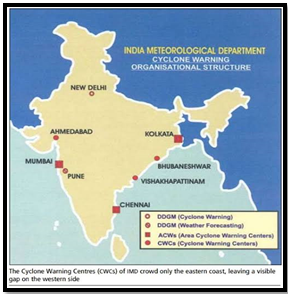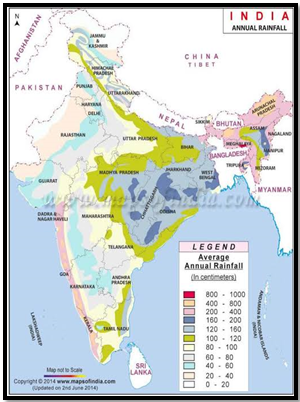GEARING UP FOR CHANGE
(Regional Specific Climate Pattern)
Syllabus:
- GS 1 : Important Geophysical Phenomena
Why in the News?
- The India Meteorological Department (IMD), responsible for delivering public weather services, will mark its 150th anniversary on January 15, 2025.
- In celebration of this significant milestone, IMD has scheduled a nationwide celebration to take place in all sub-offices.
- The commemorative events will extend from January 15, 2024, to January 15, 2025, highlighting the department’s longstanding presence and contributions in the field of meteorology.
Source : IMD
About India Meteorological Department (IMD)
- Overview:
- The National Meteorological Service of India, functioning as the primary government agency for meteorology and related subjects.
- Operated under the Ministry of Earth Sciences, Government of India.
- Historical Background:
- Founded in 1875 after devastating cyclones exposed the lack of a monitoring system for atmospheric parameters.
- The India Meteorological Department (IMD) marked its 150th year, originally conceived during colonial times to understand the mysteries of the southwest monsoon.
- The British administration’s concern for revenues drove interest in predicting monsoon patterns due to their impact on harvests.
- Objectives:
Meteorological Observations:
- To conduct meteorological observations.
- Provide real-time and forecasted meteorological information crucial for activities like agriculture, shipping, aviation, etc.
Warning Against Severe Weather:
Alert and warn against severe weather phenomena such as cyclones, norwesters, duststorms, heavy rains, snow, cold and heat waves causing potential harm to life and property.
Meteorological Statistics:
Provide essential meteorological statistics for agriculture, water resource management, industries, oil exploration, and other national development activities.
Research Promotion:
Conduct and promote research in meteorology and related disciplines.
- Evolution of IMD Over The Years
- Early Operations:
From its initial focus on southwest monsoon, the IMD now analyzes a broad spectrum of climate and weather, encompassing cyclones to fog.
Commenced with HF Blanford as the Imperial Meteorological Reporter.
- Monsoon Understanding:
Significant progress under Gilbert Walker in 1903, identifying large-scale atmospheric oscillations, contributing to modern El Niño comprehension.
- Growth and Expansion:
Over 150 years, expanded with permanent observatories and automatic weather stations nationwide.
- Advancements in Cyclone Forecasting:
- Key developments after the 1999 Odisha super cyclone prompted increased technology and personnel investments.
- Effective forecasts reduced cyclone-related casualties, with forecast services extended to 13 countries in the region.
- Diversified Roles:
Initially focused on weather forecasting, IMD now serves specialized roles in elections, sporting events, space launches, and various sectors.
- Global Role and Recognition:
- Recognized as the Regional Climate Centre for South Asia.
- Collaboration with the United Nations’ ‘Early Warning for All’ programme, contributing to 30 identified countries.
- Contemporary Relevance of IMD :
- The colonial focus on weather at regional levels, driven by revenue considerations, finds contemporary relevance in crafting region-specific plans to enhance climate resilience.
- Prioritizing regional and sub-district forecasts over national ones is seen as a commendable step forward for the government.
| What is Meteorology ?
Meteorology is the scientific exploration of the Earth’s atmosphere, concentrating on comprehending and predicting weather patterns, atmospheric occurrences, and climate. This field encompasses the scrutiny of atmospheric elements like temperature, humidity, air pressure, wind, and precipitation, aiming to forecast weather conditions and investigate the mechanisms steering the Earth’s atmospheric system. |
Monsoon Trends In India :
Monsoon Trends at Tehsil Level:
- A study by the Council on Energy, Environment, and Water (CEEW) analyzed IMD data from 1982-2022 at the tehsil (sub-divisional) level.
- Findings reveal that monsoon rainfall is increasing in 55% of India’s tehsils, with 11% experiencing decreasing rainfall.
- About 68% of the tehsils with reduced rainfall faced declines in all four monsoon months, impacting kharif crop sowing.
- Regions affected include the Indo-Gangetic plains, northeastern India, and the Indian Himalayan region.
Regional Disparities and Changes:
- 30% of India’s districts witnessed years of deficient rainfall, while 38% experienced excessive rainfall.
- Dry regions historically, like some tehsils in Rajasthan, Gujarat, central Maharashtra, and parts of Tamil Nadu, are becoming wetter.
- Changes in the northeast monsoon, impacting peninsular India, show an increase in rainfall in Tamil Nadu, Telangana, and Andhra Pradesh.
Northeast Monsoon Variations:
- Northeast monsoon rainfall has increased by over 10% in the past decade (2012-2022) in about 80% of tehsils in Tamil Nadu, 44% in Telangana, and 39% in Andhra Pradesh.
- While the southwest monsoon constitutes 76% of India’s annual rainfall, the increasing frequency of dry and wet spells prompts further research on natural variability versus global warming.
Source: Researchgate
Understanding Monsoon in India
Monsoon Divisions in India
India experiences a ‘monsoon’ climate, primarily found in the south and southeast of Asia. Two out of India’s four seasonal divisions are dedicated to the monsoon climate.
Southwest Monsoon Season:
- Seasonal rainfall occurs from June to September.
- Crucial for activities like agriculture.
Retreating Monsoon Season:
- October and November are marked by retreating monsoons.
- The Eastern Peninsula experiences significant rainfall associated with cyclonic depressions originating over the Andaman Sea.
Factors Influencing Southwest Monsoon Formation
Inter Tropical Convergence Zone (ITCZ):
- Large trough of low pressure where northeast and southeast trade winds converge.
- Shifts position over the Ganga plain during summer.
- Differential Heating and Cooling: Low pressure on Indian landmass due to differential heating and cooling of land and water.
- High-Pressure Area East of Madagascar:
Presence affects Indian monsoon intensity and position.
Tibetan Plateau Heating:
Intense summer heating results in low pressure over the plateau.
- Westerly and Easterly Jet Streams: Movement and positioning during summer impact monsoon dynamics.
- Southern Oscillation (SO):
Periodic reversal of pressure conditions in the Pacific Ocean.
El Nino:
Temporary warm ocean current along the coast of Peru affecting sea-surface temperatures and trade winds.
Mechanism: Onset of Southwest Monsoon
- ITCZ shift and winds from the Arabian Sea and Bay of Bengal.
- July sees Monsoon Trough development in the Indo-Gangetic Plain.
- Position change related to withdrawal of westerly jet stream and presence of the easterly jet stream.
Retreating Monsoon Season
- Marked by clear skies, temperature rise, and oppressive weather.
- Widespread rain in the east due to cyclonic depressions originating over the Andaman Sea.
- Impactful for farming and water security in the south.
Impact of Monsoons on Life in India
Positive:
- Agricultural Dependency: 64% of Indians depend on agriculture. Agriculture relies on timely and adequate rainfall
- Regional Variations: Different crops thrive due to regional monsoon variations.
- Food and Resources: Variety in food, clothes, and housing.
- Hydro-Electric Power: Monsoon rain recharges dams for hydro-electric power.
- Rabi Crops: Winter rainfall aids Rabi crops.
Negative:
- Droughts and Floods: Variability causes droughts or floods.
- Soil Erosion: Sudden monsoon bursts lead to soil erosion.
- Landslides: Hilly areas face landslides disrupting life and infrastructure.
| Key Terms
ITCZ (Inter Tropical Convergence Zone): ITCZ is a low-pressure area near the equator where trade winds converge, influencing monsoon patterns and causing tropical weather phenomena like heavy rainfall. El Niño: El Niño is a periodic warming of ocean currents off the coast of Peru. It affects global climate patterns, leading to abnormal weather conditions and disruptions. Jet Streams: Jet streams are high-altitude, fast-flowing air currents in the atmosphere. The polar and subtropical jet streams influence weather patterns, impacting cyclones, storms, and aviation routes. |
The IMD’s rich historical evolution provides a foundation for addressing the modern challenges of climate change.
Regional disparities and evolving monsoon patterns necessitate nuanced planning for climate resilience, urging the government to prioritize localized strategies over broader national approaches.
Mains Practice Question:
Discuss the changing patterns of the Indian monsoon and its implications on various sectors such as agriculture, water resource management, and regional climates.

 Source : IMD
Source : IMD Source: Researchgate
Source: Researchgate

